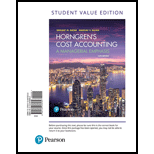
1.
Material Requirement Planning (MRP) System:
The system that produces the finished goods with the help of raw material and semi finished goods is known as the material requirement planning. It involve the planning and controlling of inventory in such a way that the production will optimally generate.
Economic Order Quantity (EOQ):
Economic order quantity is the quantity of order that is purchased from supplier at a time, the EOQ aim is to reduce the carrying and ordering cost of inventory. EOQ is also referred as the optimum level of lot size.
Just-in-Time (JIT) Inventory:
Just in time inventory approach means to purchase the inventory when it is needed. This approach does not consider the storage of inventory factor. Most of the companies use this approach to avoid the wastage arises due to extra inventory. When the need of inventory arises the purchase manager will purchase the inventory from supplier.
To compute: The actual cost of producing and carrying units in inventory using MRP system.
2.
The optimum batch size and number of batches also calculate the annual cost of producing and carrying if the company uses optimal batch size. Compare this cost with the cost calculated in part1.
3.
To compute: The actual cost of producing and carrying units in inventory using JIT system.
4.
To explain: The MRP system and JIT system and there advantages and disadvantages.
Want to see the full answer?
Check out a sample textbook solution
Chapter 20 Solutions
Horngren's Cost Accounting, Student Value Edition (16th Edition)
- Please show me the correct approach to solving this financial accounting question with proper techniques.arrow_forwardWhat is the correct answer with accountingarrow_forwardPizza Ventures has a net income of $58,200 and total equity of $145,500. What is the ROE? A)38.2% B) 41.5% C)40.0% D) 43.2%arrow_forward
- Nonearrow_forwardDodge Enterprises has net sales of $920,000, cost of goods sold of $480,000, and total operating expenses of $275,000 for the fiscal year ended December 31, 2024. 1. What was the gross profit on sales? 2. What was the net income from operations?arrow_forwardGeneral accountingarrow_forward

 AccountingAccountingISBN:9781337272094Author:WARREN, Carl S., Reeve, James M., Duchac, Jonathan E.Publisher:Cengage Learning,
AccountingAccountingISBN:9781337272094Author:WARREN, Carl S., Reeve, James M., Duchac, Jonathan E.Publisher:Cengage Learning, Accounting Information SystemsAccountingISBN:9781337619202Author:Hall, James A.Publisher:Cengage Learning,
Accounting Information SystemsAccountingISBN:9781337619202Author:Hall, James A.Publisher:Cengage Learning, Horngren's Cost Accounting: A Managerial Emphasis...AccountingISBN:9780134475585Author:Srikant M. Datar, Madhav V. RajanPublisher:PEARSON
Horngren's Cost Accounting: A Managerial Emphasis...AccountingISBN:9780134475585Author:Srikant M. Datar, Madhav V. RajanPublisher:PEARSON Intermediate AccountingAccountingISBN:9781259722660Author:J. David Spiceland, Mark W. Nelson, Wayne M ThomasPublisher:McGraw-Hill Education
Intermediate AccountingAccountingISBN:9781259722660Author:J. David Spiceland, Mark W. Nelson, Wayne M ThomasPublisher:McGraw-Hill Education Financial and Managerial AccountingAccountingISBN:9781259726705Author:John J Wild, Ken W. Shaw, Barbara Chiappetta Fundamental Accounting PrinciplesPublisher:McGraw-Hill Education
Financial and Managerial AccountingAccountingISBN:9781259726705Author:John J Wild, Ken W. Shaw, Barbara Chiappetta Fundamental Accounting PrinciplesPublisher:McGraw-Hill Education





